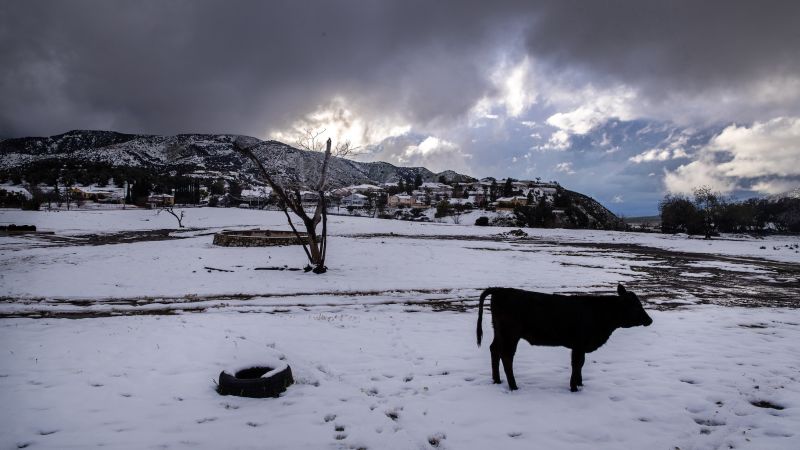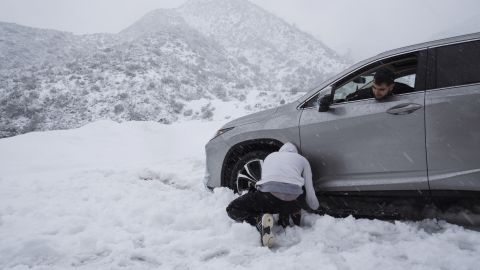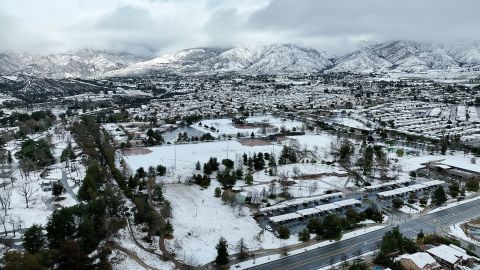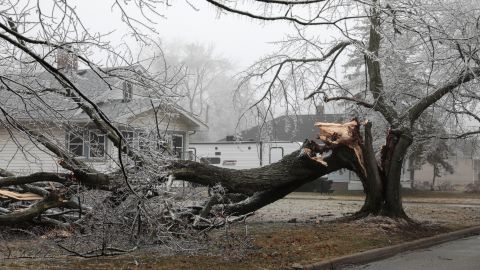Rare blizzard warnings issued in Southern California as Midwest digs out from powerful winter storm | CNN

CNN
—
A slow-moving winter storm brought snow, rain and high winds to the West on Friday, prompting rare blizzard warnings in Southern California.
In its first-ever blizzard warning, the National Weather Service in San Diego said the San Bernardino County mountains could see 3 to 5 feet of snow through Saturday morning.
Blizzard warnings were also issued for Los Angeles and Ventura counties through Saturday afternoon. Up to 5 feet of snow is possible with some isolated areas seeing between 7 and 8 feet. The National Weather Service’s Los Angeles office issued its last blizzard warning on February 4, 1989.

“This storm system will be unusually cold, and snow levels will be very low. In fact, areas very close to the Pacific Coast and also into the interior valleys that are not accustomed to seeing snow, may see some accumulating snowfall,” the National Weather Service said early Friday.
“For Friday morning through Saturday afternoon, plan to hunker down and avoid travel. The worst impacts from flooding and blizzard conditions occur Friday afternoon through Saturday morning, when any non-essential or non-emergency travel should be postponed!” the San Diego weather service said.
The National Weather Service on Friday afternoon issued a flash flood warning with a “considerable flash flood damage threat,” for Los Angeles and surrounding areas. This is the second highest level of flood warning from the NWS, only topped by a flood emergency.
Over 6 million people are covered by the warning, including downtown Los Angeles, Pasadena, Beverly Hills, Burbank and Santa Barbara.
“Flash flooding is already occurring…and is expected to worsen into the evening hours,” the NWS warning said.
The weather service also warned that debris flows are likely from previous burn scars in the region.
Up to 5 inches of rain could fall across lower elevations of the greater Los Angeles area while the mountains could see 6 inches. In the San Diego area, up to 3 inches of rain is possible in lower elevations while the mountains could get 7 inches.
The storm has put more than 20 million people under flood watches and more than 30 million people under high wind alerts across Southern California – roughly two months after the state endured rounds of deadly flooding. The highest gusts in the warning areas could reach 75 mph.
The storm system will impact Northern California early in the day Friday. Up to 6 inches of snow is possible across lower elevations and up to 3 feet could fall on the region’s highest peaks before conditions begin to improve by Friday evening as the storm slips to the south.
The Sierra Nevada Mountains could see up to 6 feet of snow Friday into Saturday and in Nevada, a blizzard warning for northwestern Nye County will be in effect Friday morning through early Saturday.
“Heavy snow, winds gusting as high as 60 mph, will cause zero visibility due to blowing and drifting snow,” the weather service warned.
Snow has already hit the Santa Cruz Mountain, resident Ngugi Kihara told CNN on Friday.
“We never seen this much snow up here,” Kihara said. “We woke up to it. It started yesterday but picked up a lot overnight. Lots of trees are falling and all the roads around us are closed. Power is out and has been mostly gone since Tuesday.”

Power outages were already adding up in California early Friday, with nearly 75,000 customers in the dark, largely in the northern region. That accounts for a small portion of the more than 820,000 power outages recorded nationwide as the day began, according to PowerOutage.us. The majority of the outages – nearly 720,000 – were in Michigan, where freezing rain and ice this week damaged utility lines and trees.
The storm struck the West as a ferocious, multiday winter storm began to subside after wreaking havoc in several states across the West, northern Great Plains the Great Lakes region and New England.
Several counties in Wyoming went into search-and-rescue mode after more than 40 inches of snow fell in the southern parts of the state over the course of several days and motorists were trapped in heavy snow, the state highway patrol said on Twitter.

Minneapolis, Minnesota, saw more than 13 inches in a three-day period this week. More than 160 vehicle crashes were reported statewide, and dozens of cars spun off roads Wednesday, a spokesperson for the Minnesota State Patrol said in a series of tweets.
Minneapolis officials have declared a one-day snow emergency beginning Friday, and city crews have been plowing and treating streets.
Since the storm began Monday evening, cumulative snowfall reached dozens of inches in some cities, including 48 inches in Battle Lake, Wyoming, 32 inches in Dupuyer, Montana, and 29 inches in Park City, Utah.
But snow was not the storm’s only culprit. Severe icing was also a danger.
Ann Arbor, Michigan, recorded 0.65 inches, while Fransville, Wisconsin, measured 0.75 inches of ice.
And in New England, icy conditions likely contributed to a massive 15-vehicle pileup on the Massachusetts Turnpike Thursday night, according to a tweet by the Massachusetts State Police.
The chain-reaction crash involved multiple personal vehicles and tractor trailers, officials said. Troopers, firefighters and EMS responded to the incident and multiple victims had to be transported to the hospital, according to the tweet.
As northern regions of the country were measuring snowfall and ice accumulation, parts of the Southeast were experiencing record-high heat.
More than 50 daily record highs were recorded in the Southeast Thursday.
- St. Simons Island, Georgia, saw a high temperature of 88 degrees, an all-time February record.
- Tupelo, Mississippi, reached a high temperature of 87 degrees, another an all-time February record. The previous record of 84 degrees was set Wednesday.
- Raleigh, North Carolina, saw a high temperature of 85 degrees, which was an all-time February record. The previous record of 84 degrees was set in 1977.
The dueling winter storm and southern heat wave created a stark 100-degree temperature difference between the Northern Rockies and the South earlier this week.
[ad_2]
Share this news on your Fb,Twitter and Whatsapp
Times News Network:Latest News Headlines
Times News Network||Health||New York||USA News||Technology||World News